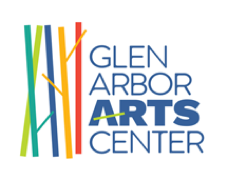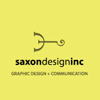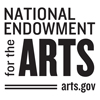
Creativity Q+A with Laura Korch
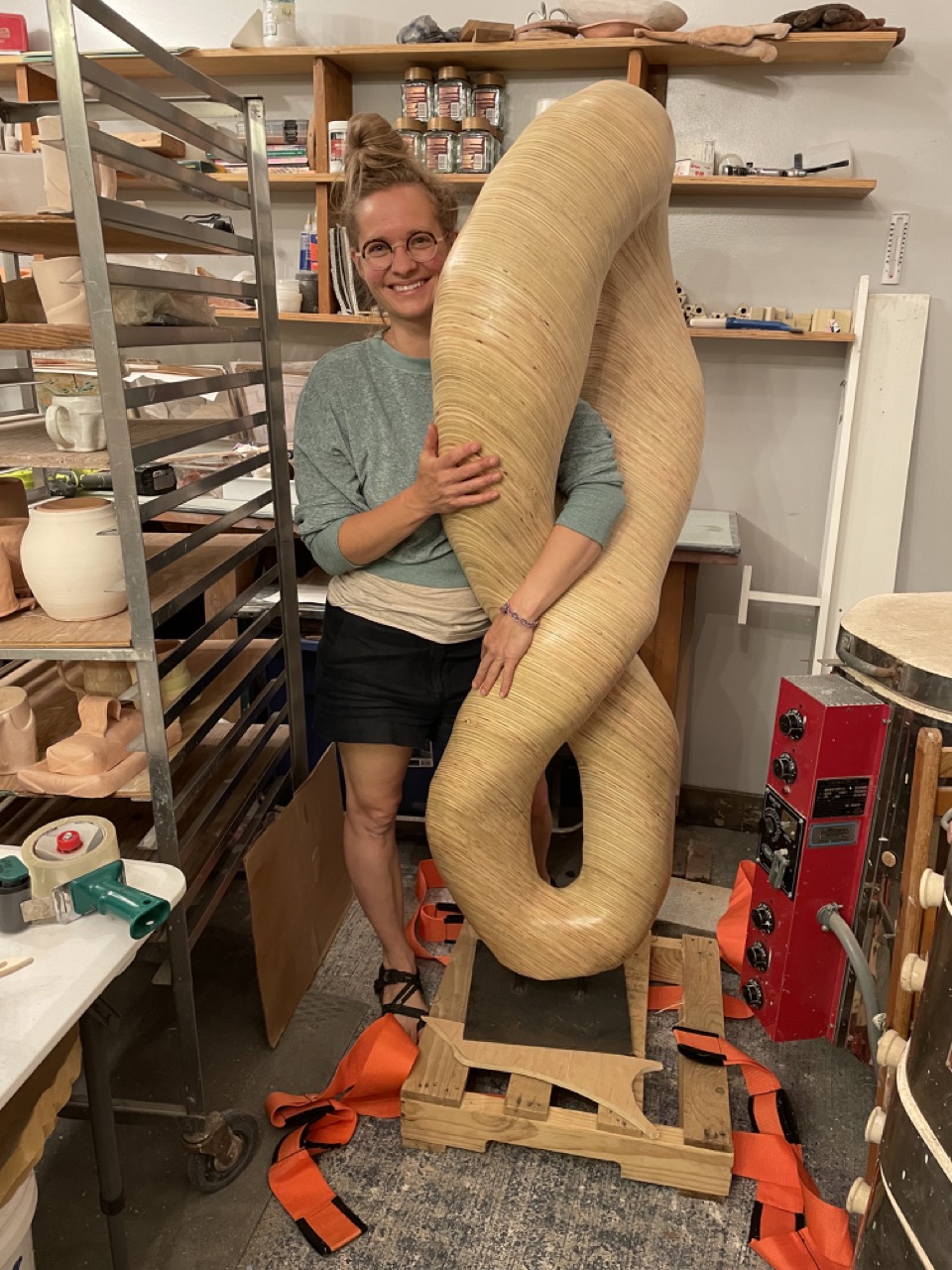
Laura Korch joined the Northwestern Michigan College art department in August 2023. She runs the ceramics and sculpture programs. “I had a very strong pull to [clay] as a child,” said the 43-year-old Traverse City resident. “As my work in pottery began changing into sculpture, I went to grad school [Arizona State] and started painting, and working with wood, and welding with steel. Now, my work can be a lot of different things”: vibrating wooden tubs, and walls of depressed coffee cups for starters. School cross-pollinated with studio work. Studio work cross-pollinates with teaching. It’s all of a piece.
This interview was conducted in March 2024 by Sarah Bearup-Neal, GAAC Gallery Manager, and edited for clarity.
Pictured: Laura Korch
Describe the medium in which you work.
I primarily use clay. I had a very strong pull to that as a child. As my work in pottery began changing into sculpture, I went to grad school and started painting, and working with wood, and welding with steel. Now, my work can be a lot of different things. It mostly lands on clay and ceramics; but sometimes there’s an interdisciplinary approach. Sculptures are wood and metal with glaze and house paint. Or, one of my most ambitious projects was a giant, wood, interactive sound sculpture. People laid into this life-sized sculpture, and there were shakers that would pulse a two-way frequency at 528 hertz. When the person laid down they would insert their arms into these two tunnels that formed the shape of a large hug. The sculpture would then begin to slowly comfort and vibrate them with these frequencies.

I originally came up with the idea, as controversial as it may sound, in 2011. I was in Thailand, and was with a group of people who were living in Southeast Asia. I was going to ride an elephant. I was in this amazing jungle with a 15-year-old tour guide. At one point, we swapped seats, so I got to put my legs around the elephant’s neck. She had just given birth, so she was massive. And, she vibrated. She was rumbling. And, I thought everything in the universe vibrates. It was such an enlightening moment with this creature. Seven years later, this wood sculpture burst out from those travels, and that experience.
When you use clay in a sculptural capacity, there are remnants of its functional personality — but you’ve moved it beyond the functional into something else. Talk about that.
I was always fascinated with the pottery wheel. I thought that in conjunction with learning about clay as a material — there’s endless exploration with that material — I was so rooted in functional making, and wanting to be a full-time potter for more than a decade; by the time I was making sculpture, it was a surprise to me that I could open up enough to step away from the entrenched mud of [function-oriented] pottery. So, what you’re seeing is someone with a strong foothold and passion for functional pottery beginning to explore what it means to un-remember what I’ve learned, and try to approach it in a new way, which sometimes seems impossible. I do branch out, and sometimes I can succeed in making sculpture of various sizes out of clay. It’s most effective when I can combine the clay with another material. It reprograms my mind. It plays tricks on me so that I can’t settle into that habit of working with the material.
You’ve talked about yourself as a sculptor who works in a variety of materials. What draws you to sculpture?
It’s funny. It came about unexpectedly. I found myself working with the material in a different way than I was used to, and challenging the material at its maximum capacity. For example: I’d roll out these thin coils out of porcelain clay, and pinch it, make it into a ring, and I’d made 50 of these. The dry time for porcelain is very short — it goes from being soft to hard very quickly. I chose to stack all these rings with little clay pegs to make these fragile, cage baskets. That was a stepping stone for me. I became fascinated with this new way of working. And, also, from that, began thinking of concepts.
You received a BFA from Eastern Michigan in 2004, and your MFA from Arizona State in 2019. What happened in between?
I apprenticed with John Glick, a master potter, in Farmington Hills [Michigan] for a year. Next, I was hired as a ceramics studio manager for the Ann Arbor Arts Center, and that was when I first started teaching adults, and I had to begin explaining all the nuances of what I was doing with the material. That was a humbling period in my life. In 2007, I moved to North Carolina. There’s so much local clay. There was a low cost of living. And, I began teaching at several different art centers. At one of them, I was able to rent studio space — for pennies — for five years. Clay-makers had a cordoned off studio space there, and it was a very supportive community. Meanwhile, working at Trader Joe’s part-time. I was trying to make it as a potter. I was practicing selling at craft fairs, applying to exhibitions and shows. Finally, I bought a house in 2012 and renovated a garden shed [into a home studio]. Once these rings of sculpture came into my studio work, I took a four-week residency at Alfred University, which is one of the best ceramic schools in the nation and got to work with John Gill. I talked to the grad students there, and was convinced that I needed to go to grad school. That was why there was this gap. I was content with how I was living.
How did your formal training affect your development as a creative practitioner?
It affected everything. I’m definitely a product of academic training. In middle school, there was a ceramics department where I learned to hand build, sculpt and throw. In high school, I was convinced the only reason I was going was to take pottery classes. Our ceramics studio was huge. I felt like I had tons of support from teachers — we were glaze testing, raku firing, we had 12 wheels. When I went to college, I chose EMU because Diana Pancioli was there. She was an Alfred grad, and working very functionally.
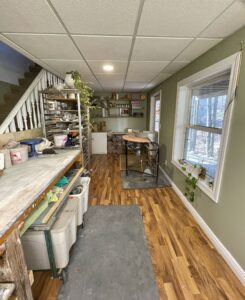
Describe your studio/work space.
Here in Traverse City I’m occupying half the basement. We’ve put up a wall with a door. On the other side is a giant window and a door — so I can move things out the door if I can’t shimmy them up the stairs. I’m also occupying the laundry room — in this ground-floor basement. I’m able to have my kilns in there, a sink, and my oversized extruder. I’m storing my raw materials in that room, too. Now, I’ve got spaces to spread out. Originally I thought we’d build a studio off the garage, and I had plans for space where I could do welding. But it’s really hard to combine wood and clay. Currently, with me working for NMC, I’m able to use the welding shop if I need to.
What ideas are the focus of your work?

Usually, it’s whatever has called me to do. I went through a lot of life-changing events at the end of grad school that lead me to mysticism, Kabbalah, meditation. My work became more about these interactive sculptures that branch connection and consciousness. A lot of the time, I move into the work with that intention — whether of not it’s part of it. I’m still trying to embed it into the process of making. Currently, in the last three years, I have an agent. Tim McElligott, who is the owner of Curator Engine, approached me after my grad thesis exhibition, and said he wanted to work with me — whether it was the sculptures for businesses, or [other clay constructions]. He and I have been working for a number of years, and he’s bridged these connections with developers. What has ended up happening is I’ve gotten commissions through Curator Engine. Tim has a portfolio of artists that he takes to developers. There have been times when Tim will show me the color palette. The building has been constructed, here’s the parameters of the scale of the work we’ll need. We’re looking for a sculpture here, we’re looking multiple pieces there. What ideas do you have? I’ve really enjoyed this way of working. I got really burned out after grad school, and felt like I was giving up the rat race. I could never do enough. The artist in America has to be the photographer, the marketer, the maker. I got so tired of running hard with that game. These commissions work great for me. I don’t have to search out to the client. My agent is doing that. I get to stay in my studio and work. I’m not traveling all over the country to do art fairs. Instead, I have a couple gallery shops where I have pottery and sculpture, that sell really great. It keeps me in my space, working and making the way I want to do it.
It sounds like the themes and ideas for your work come out of these commissions.
That first commission, I came up with the idea of what to make; but there were parameters, and parameters can be really helpful.
The clients are saying, I have this space, and I like this, and what can you make of it? You come up with the creative juice?
And, my agent is not an artist. He has his masters in business; but he’s become pretty savvy over the years working with all these different artists [he represents].
What’s your favorite tool?
That’s changed over time. My first thought was my hands. We essentially, as a civilization, built everything with our hands. At different times I would have said [her favorite tool is] a pottery wheel, a kiln. Welding makes me feel like I’m looking into the universe with that light.
At this moment in time, what is your favorite tool?
My intuition. It’s a muscle I like to try to strengthen and flex. It’s learning to trust what I don’t already know. Putting my faith into the [belief] that my gut will tell me that the ideas will come.
Why is making-by-hand important to you?
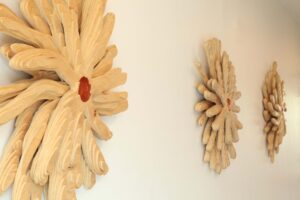
It has been a compulsion for me. It’s what I’ve been destined to do. I was enthrall to the process in elementary school. In fifth grade I had a teacher who let us do pinch pots, and I think that lit a spark for me. I always enjoyed art classes; but clay is grounding. The hands do the thinking. It’s even exciting to think, What’s the proper way to use a hammer? There’s a certain way you hold it. There’s a certain way you swing it; and we’re empowered by using our hands. It’s an extension of ourselves.
Why does working with our hands remain valuable to modern life?
To each their own.There are people working in other mediums who may not be using their hands as much. I think it keeps us human — but I’m not stuck in that either. Back in 2005, we did a throwing day where we put the pottery wheels up on a table and we were throwing with our feet. It was silly and playful; but our feet are a lot like our hands. For me to touch something is for me to understand it.
What role does social media play in your practice?
I was putting a lot of pressure on myself to promote myself and my art work. I did that for a time. I do still have a few things on Etsy; but that’s a hidden closet. So, I would post on Instagram and Facebook, and I found that it drained me. It was not fulfilling. Reflecting on how I wanted to live my life with more intention, I turned away [from social media]. Now, when I finish a big commission, social media becomes a place of celebration for me. To show, and to share with other people what I’m doing.
What do you believe is the visual artist’s role in the world?
I talk about this question with my modern art history students. I believe artists are here to show that everyone around them is also creative. Maybe that’s not as obvious; but I think that’s what we’re here to do. Art work is another form of communication — just like sound and music are different ways of communicating. If we can demonstrate doing anything in joy and love, that’s the point; and also reminding people of their own creativity.
How does living in Northern Michigan inform and influence your creative practice?
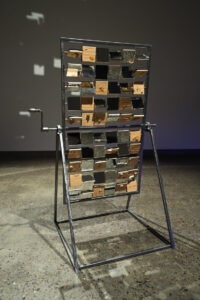
I am a Michigan native. I grew up downstate [in Highland, Michigan]. I moved away in 2007, then moved back to Michigan in 2023. I was part of a huge, vibrant, progressive community in Durham [North Carolina]. My neighborhood was revitalized and thriving; but I lived next to a really loud freeway. Especially during COVID, it was wearing on me. The noise. The street lights were very bright; I had light-dampening curtains. I knew I wasn’t going to be at that house forever; but I was there for 12 years. Because of all the travel I’ve done, the timing was good to want to be near family again. My parents live up here half of the year, and this is the first time I’ve lived near them in 15 years. But, also, I was pining for a healthier environment for my emotional and mental wellness. We’re living in an old 1970s neighborhood [in Traverse City] that’s hilly and wooded, and it’s silent. When we go to bed at night and turn off the lights, we can’t see our hands six inches in front of our faces. I was craving this. I think the influence it has is that I have the capacity to expand. I feel like physically I’m expanding. Mentally I’m expanding. The weather here makes me feel childlike and free. It’s doing all kinds of wonderful things for my artwork. Making art involves a lot of rest. I know what it means to be completely depleted. So I want to be excited with I start a project, and scared, and challenged, and uncomfortable, and then I want to rest. This is the perfect environment.
Did you know anyone, when you were growing up, who had a serious creative practice?
Anyone who was a professional artist wasn’t someone I knew in childhood. My aunt taught me how to meditate. She had projects going on on the sidelines: wood shop, she could work with metals, she even knew how to throw on a wheel. She was very conscious. She’d talk about faith and god and mysticism, so I felt as though she lived her life creatively. She was also different. She was the black sheep of the family. So, I had this hippie aunt who was really creative.
Who has had the greatest and most lasting influence on your work and practice?
This intuition, trusting that I’ll know, this channeling of god creativity has been the biggest influence. Instead of taking all the responsibility, and thinking, These are my ideas. I’m creative; I started thinking, Where is this light bulb, and all these pops of ideas, coming from? Who’s lining up all these synchronicities? I think it’s this collective consciousness of being these expressions of god that work and move through us.
Where or to whom do you go when you need honest feedback about your work?
I’m so lucky. I’ve made really great friends from my grad school peers. There’s a handful of them I’ll go to. A few of my professors. On the daily, I’m in touch with my partner, Nick. He’s a musician. It’s fun to show things to my aunt, too, because she’s not fooled by art trends. She’s pretty cut and dry, and can weed out the bullshit. I have a lot of resources, including my new peers at NMC.
What is the role of the exhibition in your practice?
That ties into what I said about the pressure to advance your CV, to work. In general, I do like exhibiting. I love the chance to showcase a body of work that gives me a lot of information about what I’m doing — which I can see when all the pieces are shown together a a group. It’s fun to be part of a group exhibition because now you’re interacting with other pieces, or a theme. Most currently, that my commissioned works are like permanent exhibitions. They’re in these collections, on display.
How does the work of your day job cross-pollinate with your studio practice?
Over the years, my perception has changed a lot on how I view life and my work. First off, grad school has really prepped me for this way of living, being able to juggle a lot of different things at the same time. I’m so relieved to have a full-time art instructor position that I’m also energized from teaching. It’s an invigorating environment. And, because of grad school, I still have the energy to do my own work. You learn structures and schedules in undergrad; but you learn endurance in grad school. Right now I’m in a really good spot.
Learn more about Laura Korch here.
Sarah Bearup-Neal develops and curates Glen Arbor Arts Center exhibitions. She maintains a studio practice focused on fiber and collage.
